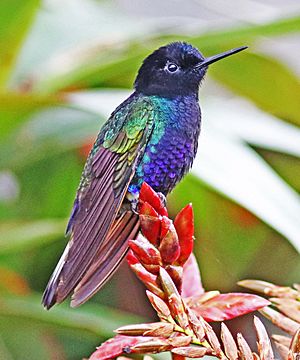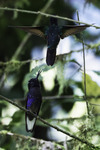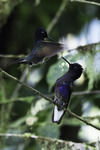Velvet-purple coronet facts for kids
The
Quick facts for kids Velvet-purple coronet |
|
|---|---|
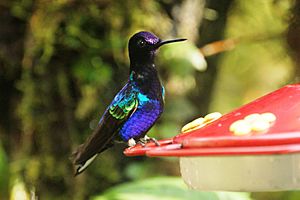 |
|
| Conservation status | |
| Scientific classification | |
| Genus: |
Boissonneaua
|
| Species: |
jardini
|
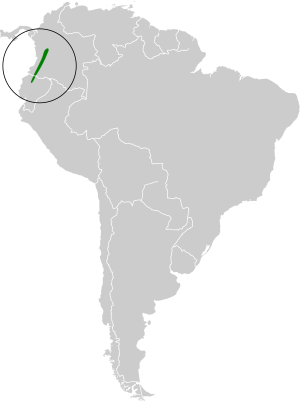 |
|
The velvet-purple coronet is a beautiful type of hummingbird. Its scientific name is Boissonneaua jardini. This amazing bird lives in the forests of Colombia and Ecuador. It's part of a group of hummingbirds called "brilliants."
Contents
About This Hummingbird
The velvet-purple coronet belongs to a family of birds called hummingbirds. It shares its genus, Boissonneaua, with two other similar birds. These are the chestnut-breasted coronet and the buff-tailed coronet. This means they are close relatives. The velvet-purple coronet is the only type of its species, which is called "monotypic."
What Does It Look Like?
The velvet-purple coronet is about 11 to 12.7 centimeters (4.3 to 5 inches) long. It weighs around 8 to 8.5 grams (0.28 to 0.30 ounces). Both male and female birds have a short, straight, black beak. They also have a small white spot right behind each eye.
Both sexes have a tail that looks notched at the end. The female's tail is not as deeply notched as the male's. They also have tiny white fluffy feathers on their legs.
Male birds have a head that looks like velvety black. Their crown, which is the top of their head, is a shiny purplish blue. The rest of their upper body is a sparkling bluish-green. Their throat is velvety black. Their chest and belly are a bright, glittering purplish blue. The feathers under their wings are cinnamon-colored. You can see these colors when the bird flies. The middle feathers of their tail are black. The other tail feathers are white with black tips and edges.
Female birds look similar to males. However, their colors are not as bright. The feathers on their chest and belly have buff or grayish-brown edges.
Where It Lives
The velvet-purple coronet lives along the Pacific side of the Andes Mountains. You can find it from southwestern Colombia to northwestern Ecuador. It mostly lives inside and at the edges of wet, mossy forests. These can be old, untouched forests or forests that have grown back. It also lives in areas with lots of shrubs.
These birds have been seen at different heights. In Ecuador, they live between 800 and 1,700 meters (2,600 to 5,600 feet) high. In Colombia, they are found between 350 and 2,200 meters (1,100 to 7,200 feet) high. They are most common above 1,200 meters (3,900 feet).
How It Behaves
Movement
The velvet-purple coronet usually stays in one place. It does not travel far. However, in Colombia, these birds are known to move to different heights depending on the season.
Feeding
This hummingbird is very protective of its food. It defends groups of flowers from other birds that want to drink nectar. It looks for food at any height in the forest, from low bushes to the tops of tall trees.
When it feeds, it holds onto the flower. It keeps its wings open for a second or two after landing. Besides drinking nectar, it also catches small insects. It does this by flying out from a perch to snatch them in the air.
Reproduction and Life Cycle
The velvet-purple coronet's breeding season starts at least from January to March. It might even last until September. The bird builds a cup-shaped nest. It uses moss and lichen to make it. The nest is placed on a horizontal branch or in a small fork of a tree.
The female bird sits on the eggs to keep them warm. She lays two eggs in a clutch. We do not know how long it takes for the eggs to hatch. We also do not know how long it takes for the young birds to be ready to fly.
Vocalization
The male velvet-purple coronet has a special song for courtship. It is described as a series of sounds. These sounds go back and forth between harsh and soft whistles. It sounds like "si, siii, si, siii, si, siii..."
Its Status
The IUCN (International Union for Conservation of Nature) has looked at the velvet-purple coronet. They have decided it is a species of "Least Concern." This means it is not in immediate danger of disappearing. However, it lives in a somewhat small area. Its total population size is not known. Experts think its numbers might be going down. It is considered uncommon and found only in certain places.
Gallery
See also
 In Spanish: Colibrí sietecolores para niños
In Spanish: Colibrí sietecolores para niños



